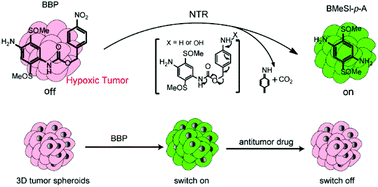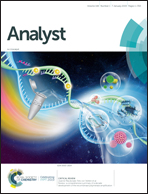A sensitive and fast responsive fluorescent probe for imaging hypoxic tumors†
Abstract
Nitroreductase activities are positively associated with the hypoxic level of tumors, making it an attractive target for tumor detection. Herein, we have developed a 2,5-bis(methylsulfinyl)-1,4-diaminobenzene based probe (BBP), which is a nitroreductase (NTR) responsive fluorescent probe and can rapidly detect NTRs with high sensitivity and specificity. The BBP showed not only a selective response to NTRs over other biological reductants, but also high sensitivity to NTRs and could detect as low as 20 ng mL−1 NTRs. Furthermore, the BBP responded rapidly to NTRs in as fast as 10 minutes, enabling real-time monitoring of the production levels of NTRs. Most importantly, the BBP could identify NTR activities in 2D cell monolayers, 3D tumor spheroids, and even solid tumors in mice. Particularly, the BBP could monitor the early tumor formation and treatment response via measuring NTR activities. Overall, the BBP appears to be an ideal imaging probe for the detection of solid tumors, and possesses great potential in a broad range of diagnostic and therapeutic applications in the clinic.



 Please wait while we load your content...
Please wait while we load your content...